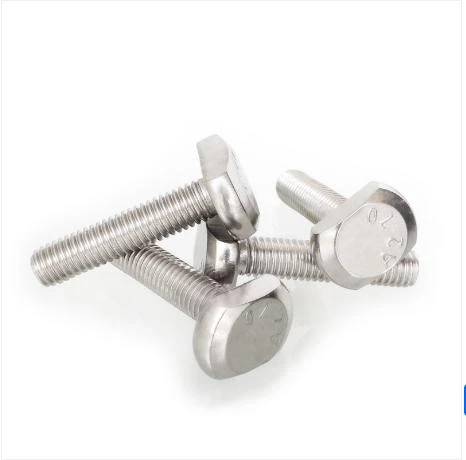

types of hexagonal nuts
Th11 . 23, 2024 20:37 Back to list
types of hexagonal nuts
Understanding Different Types of Hexagonal Nuts
Hexagonal nuts are one of the most commonly used fasteners in various industries, thanks to their effectiveness and ease of use. These nuts have a six-sided shape, which allows them to be easily tightened or loosened with standard tools like wrenches. In this article, we will explore the various types of hexagonal nuts, their applications, and why they are so widely used in mechanical assemblies.
The Standard Hexagonal Nut
The standard hexagonal nut, often referred to simply as a hex nut, is the most common type. It features a uniform thickness and is designed to be used with a corresponding bolt or screw. The internal threads of a hex nut are designed to fit over the external threads of a bolt, allowing the two to be securely fastened together. Standard hex nuts are available in different materials, including steel, stainless steel, and brass, providing options for varying strength requirements and resistance to corrosion.
Lock Nuts
Lock nuts are a specialized type of hex nut designed to prevent loosening under vibration and torque. These nuts include features such as a nylon insert or serrated edges, which grip the bolts and provide additional friction. Lock nuts are often used in applications where machinery is subject to significant vibrational forces, such as in automotive and aerospace engineering. The most common types of lock nuts are the nylon-insert lock nut and the prevailing torque lock nut.
Jam Nuts
Jam nuts, or thin hex nuts, are another variation of hexagonal nuts. They are typically thinner than standard hex nuts and are often used in conjunction with another nut to secure the assembly. By tightening a jam nut against a standard hex nut, the two work together to provide a more secure hold. This dual-nut setup helps to prevent loosening due to vibrations and is often found in applications such as machinery and automotive assemblies.
Flange Nuts
types of hexagonal nuts

Flange nuts are hexagonal nuts that have a wider base (flange) underneath the nut. This design distributes the load over a larger area, which can help to prevent damage to the surface beneath it. The flange also provides resistance against rotation and improves locking capabilities. Flange nuts are commonly used in machinery, automotive parts, and in environments where additional vibration resistance is critical.
Acorn Nuts
Acorn nuts, also known as cap nuts, feature a dome-shaped top that covers the exposed end of a bolt. This design serves both functional and aesthetic purposes it protects the bolt from damage and hazards while providing a clean, finished look to industrial assemblies. Acorn nuts are available in various sizes and materials, making them suitable for decorative applications as well as functional ones.
T-Nuts
T-nuts, or tee nuts, have a flange that allows them to be inserted into a pre-drilled hole in wood, metal, or plastic. These nuts are used to create a strong, secure fastening point and are commonly found in furniture assembly and woodworking. T-nuts can also be used in applications where access to the back of the material is limited.
Wing Nuts
Wing nuts are a type of hexagonal nut that features two large, wing-like projections, allowing them to be easily tightened or loosened by hand without the need for tools. They are often used in applications where frequent adjustments are necessary, such as in light-duty assembly tasks or in settings where quick disassembly is required. Wing nuts can be found in outdoor furniture, electronic equipment, and more.
Conclusion
Hexagonal nuts are essential components in a vast array of applications, from construction to automotive engineering. Their design offers versatility, ease of use, and the ability to create secure fastenings. With the varying types from standard hex nuts to specialized variants like lock nuts and acorn nuts, there is a solution available for nearly every fastening requirement. Understanding the different types of hexagonal nuts and their specific applications not only helps engineers and designers select the right fasteners but also ensures that assemblies are secure, reliable, and efficient. As the demand for durable and efficient fastening solutions continues to rise, hexagonal nuts will remain a staple in the world of manufacturing and construction.
Latest news
-
Hot Dip Galvanized Bolts-About LongZe|High Strength, Corrosion Resistance
NewsJul.30,2025
-
High-Strength Hot Dip Galvanized Bolts - Hebei Longze | Corrosion Resistance, Customization
NewsJul.30,2025
-
Hot Dip Galvanized Bolts-Hebei Longze|Corrosion Resistance&High Strength
NewsJul.30,2025
-
High-Strength Hot-Dip Galvanized Bolts-Hebei Longze|Corrosion Resistance&High Strength
NewsJul.30,2025
-
Hot Dip Galvanized Bolts-Hebei Longze|Corrosion Resistance&High Strength
NewsJul.30,2025
-
Hot Dip Galvanized Bolts - Hebei Longze | Corrosion Resistance, High Strength
NewsJul.30,2025

